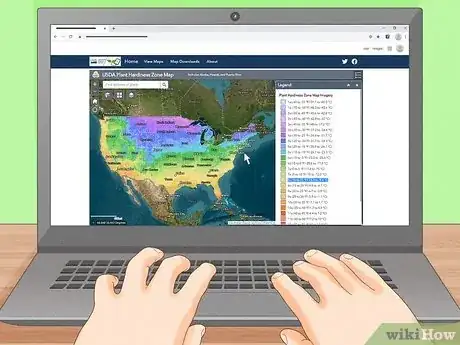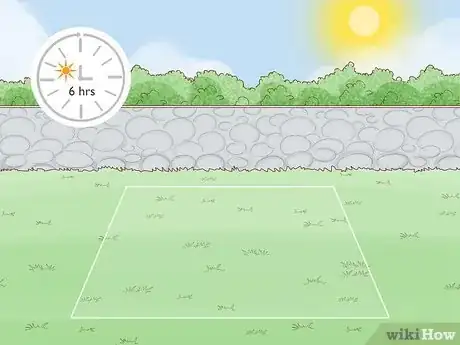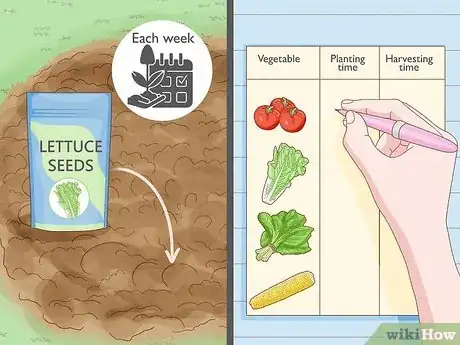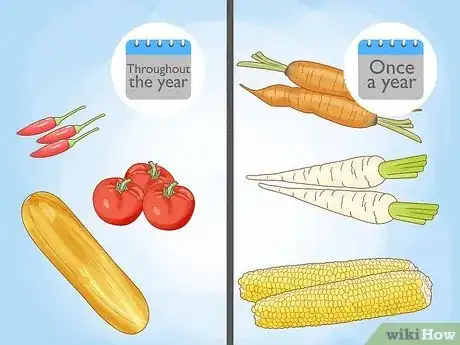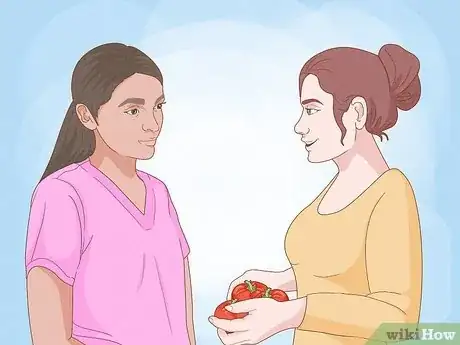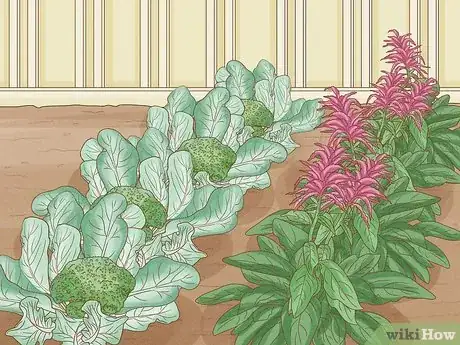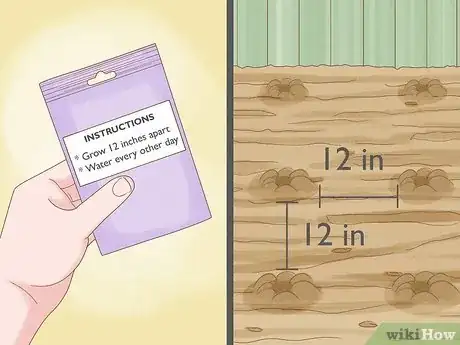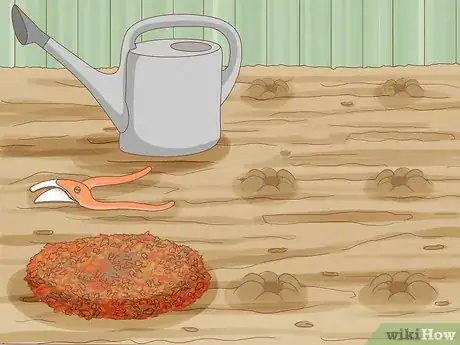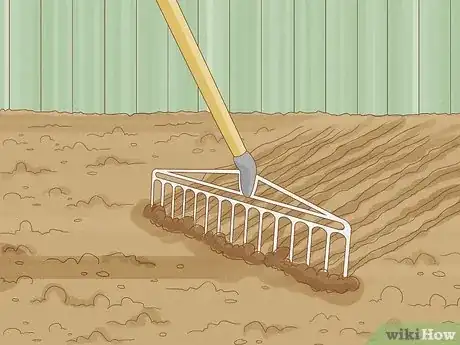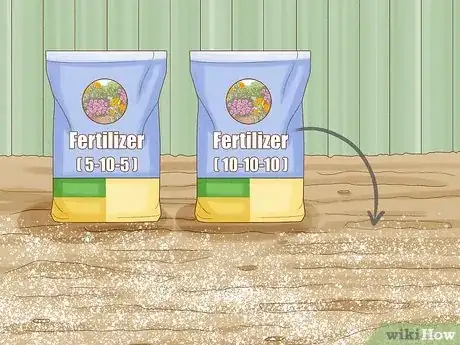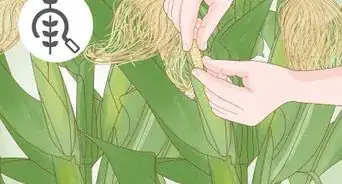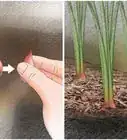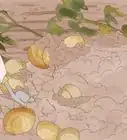This article was co-authored by Steve Masley. Steve Masley has been designing and maintaining organic vegetable gardens in the San Francisco Bay Area for over 30 years. He is an Organic Gardening Consultant and Founder of Grow-It-Organically, a website that teaches clients and students the ins and outs of organic vegetable gardening. In 2007 and 2008, Steve taught the Local Sustainable Agriculture Field Practicum at Stanford University.
This article has been viewed 45,233 times.
Growing your own vegetable garden is a rewarding experience that allows you to save money while simultaneously creating a beautiful space in your yard. If you work closely with the land and put in the labor required to grow your own delicious vegetables, you will get an immense amount of satisfaction out of picking your brightly-colored gems and devouring them for dinner. Though planting a vegetable garden is probably easier than you think, there are some definite things to consider when planting a garden for the first time. Follow the instructions below to learn how to get started planting your very own vegetable garden.
Steps
Understanding Your Climate
-
1Find out which USDA Plant Hardiness Zone you live in. Hardiness zones are based on the average minimum winter temperature in a given area and are divided into categories separated by 10-degrees Fahrenheit. They can tell you which plants will thrive in your area and which plants will not do well in the climate of your area. Additionally, you can find out when the best time of year to plant is based on your hardiness zone. Visit http://planthardiness.ars.usda.gov/ to find out which zone you live in. The interactive map will even display information about microclimates in your yard.EXPERT TIPSteve Masley has been designing and maintaining organic vegetable gardens in the San Francisco Bay Area for over 30 years. He is an Organic Gardening Consultant and Founder of Grow-It-Organically, a website that teaches clients and students the ins and outs of organic vegetable gardening. In 2007 and 2008, Steve taught the Local Sustainable Agriculture Field Practicum at Stanford University.Home & Garden Specialist

 Steve Masley
Steve Masley
Home & Garden SpecialistKnow your growing season. Steve Masley and Pat Browne, the owners of Grow it Organically, say: "You have to look for the right varieties for your climate. For instance, yellow and orange tomatoes always come in very late. If you live in the north, you wouldn't want to plant big beefsteak tomatoes or big orange tomatoes, because your growing season isn't long enough for them to ripen. Instead, look for early or mid-season tomatoes, then try to get them in the ground early so they'll ripen by the time it starts getting cold."
-
2Choose a spot with at least six hours of direct sunlight per day. Most vegetables require a lot of sunlight to grow into healthy producers, but you may want to vary the sun to shade ratio of your garden to allow for some shade growing plants as well. However, if your vegetables don't get enough sun, they won't produce as much and will be more susceptible to pests. It's best to have an idea about what plants you want to grow before choosing a site.[1]
- You can grow dark, leafy vegetables like broccoli and spinach in places in your garden that do not get full sun. If you live in an area with little sun, don't be discouraged. You can still plant a magnificent garden, though you'll probably have to leave tomatoes out of the equation.
- Alternately, if you live in an extremely hot climate, you may want to choose partial shade for some of your vegetable varieties in order to protect them from extreme heat. For example, cool-season peas may benefit from growing in partial shade.[2]
Choosing Vegetable Varieties
-
1Know when to plant. Most vegetables are planted outside around the last spring frost and are harvested anywhere between mid-summer and late-fall. Consult the specific growing instructions for each type of vegetable that you grow. To enjoy a wide variety of vegetables for the entire growing season, plant vegetables that are ready for harvest at different times of the year. That way, you won't be without fresh vegetables for long.
- You can also space out plantings of your vegetables. For example, to get a continuous harvest of lettuce, sow new lettuce seeds each week during the planting season.
-
2Know how much to plant. Often, new gardeners get over-excited about their new hobby and end up planting more than they can eat or care for. Be aware that some plants, like tomatoes, peppers, and squash produce throughout an entire growing season, and others like carrots, radishes, and corn, produce only once.[3]
- For best results, plant a mixture of continual producing and single producing vegetables in your garden. Generally, you can plant less of the continual producing vegetables and more of the single producing vegetables in order to achieve a good balance in your garden.
- Make sure you give each plant enough space to develop and thrive in your garden. You may have to thin plants out as they begin to grow in order to avoid crowding.
-
3Ask your family which vegetables they love to eat. Keep your family's favorite vegetables in mind when planting your vegetable garden. By growing the produce you buy the most of, you can greatly reduce your grocery store costs, as well as reduce waste when it comes time to harvest.
-
4Consider growing vegetables that are hard to find. Many grocery stores only carry the produce basics. Often grocery stores simply carry one variety of a tomato or a pepper, making it hard to find interesting heirloom or exotic varieties. If your climate permits, consider planting vegetables that are difficult to locate for purchase in your area. Not only will doing so allow you to cook with special vegetables, it also provides you with a great gift to give to your friends, family, and neighbors.
-
5Avoid plants that animals and pests in your area will eat. Be aware of the different vegetables that your local fauna will love to devour. To protect your vegetables from birds or deer, you may have to put up some sort of fence covering around your vegetable garden to prevent it from getting attacked by veggie-seeking predators.
-
6Decide whether to grow from seed or transplant seedlings. Most vegetables can be grown from seeds or bought as seedlings and transferred directly into the ground or a planter box.
- While some vegetables like carrots are very easy to grow from seed, others like tomatoes can be a bit more difficult. Research the process for planting each type of vegetable from seed before choosing a planting method.
- You may also want to start seeds indoors in peat pots before transplanting seedlings in the garden. Consult a growing guide for each vegetable in order to figure out planting times and the temperature that most vegetables can withstand.
- Look for plant sales in the spring. Many farmers markets and master gardener programs host annual plant sales. This will also give you a chance to get expert information from the person who started the plants.
-
7Space your plants adequately. While some gardening guides suggest planting in rows, others suggest that planting each vegetable type in a triangular shape actually allows you to preserve space in the garden. The important thing, though, is that your plants are not planted too tightly together to prevent them having to compete with neighboring plants for space.
- Look at the seed packet or the label on the plant's pot to see the provided spacing recommendations.
-
8Learn how to care for your specific plants. Each type of vegetable plant requires a slightly, if not drastically, different care routine. Do a bit of research to find out how much water your plants need, whether or not they require trimming or thinning, how often they need to be fertilized, and when they are ready for harvest.
- Most plants benefit from a layer of mulch on top of the soil. This helps regulate temperature, retains moisture, and encourages beneficial earthworms.
Prepping Your Planting Area
-
1Choose your garden foundation. Decide whether you want to plant your vegetable garden directly in the ground or build a planter box to raise your vegetables a few feet above the ground. Alternately, you may want to plant different vegetable varieties each in their own pot. Your decision should depend on the quality of your soil and the tendency of your planting area to flood. If you have poor soil quality and poor drainage, you probably want to build a raised vegetable garden bed.
- Think about how big you want your planting bed to be. Depending on the type of vegetables you plant, you'll need to make sure that the box is wide and deep enough. Conduct a bit of research on the types of vegetables you are planting to see how much space they need to grow. Broccoli, for example, utilizes a wide area to grow, while carrots simply need space to grow down.
- To build a raised planting bed, you can use lumber, plastic, synthetic wood, bricks, or rocks. However, cedar planks are generally recommended because they do not rot when exposed to water. Keep in mind that your vegetable plants will have to be watered regularly, and some weak woods like simple plywood may not last very long when constantly drenched.
- Round the top of your planting bed to achieve the maximum surface area for planting. This means that the tops are rounded to form an arc rather than a flat surface.
- Lay a barrier between the bed and the ground in order to prevent weeds from growing. You can use gardening plastic, a mat of some sort, or several layers of newspaper and/or cardboard to reduce the chance that weeds will grow.
-
2Till the soil. Most vegetables require a rich, fertile, fluffy soil to grow well. Use a quality garden hoe and/or a shovel to intensely break up the soil and prepare it for planting. You can avoid this labor altogether if you choose to build a raised vegetable garden box and fill it with pre-mixed, store-bought soil.
- Make sure your planting area is free of any rocks or clumps of thick soil to allow the roots to expand and your seedlings to grow into healthy, productive plants.
- Be sure to remove any weeds or unwanted voluntary plants from your growing space. These will just compete with your plants for space and can potentially bring in harmful pests.
-
3Test the pH of the soil. Soil pH is based on a scale of 1 to 14, with a pH of 7.0 being neutral, any values below 7.0 being acidic, and any values above 7.0 being alkaline. Most vegetables like a slightly acidic soil between 6.0 and 6.5. Soil that is too acidic will damage plant roots and cause your vegetables to under produce. Test your soil's pH by visiting your county's agricultural extension office and obtaining the necessary testing supplies and instructions. You can also pay to have your soil tested.
- The pH of the soil tells you if the soil needs limestone added in order to bring it to the desired pH value. Limestone is cheap and effective when it comes to improving soil.
- Evaluate the soil's calcium and magnesium levels in order to determine what type of limestone to add to your soil. If the soil is low in magnesium, add dolomitic limestone. If it is high in magnesium, add calcitic limestone.
- Add the limestone two to three months before planting to allow the soil to absorb it. After adding, check the pH again. You will probably need to add limestone to the soil every year or two to maintain a proper pH level.[4]
-
4Fertilize the soil. Most vegetables like soil that is rich in organic matter. You can increase the fertility of your soil by adding peat moss, mature compost, blood meal, fish emulsion, etc. The most common fertilizers recommended for vegetable gardens specifically are nitrogen, phosphorus, and potassium.
- Use soil test results to let you know what you need to add. Do-it-yourself soil tests are readily available from most home improvement and garden stores.
- Try one of these common fertilizer compositions in your vegetable garden: one pound of a 10-10-10 fertilizer or two pounds of a 5-10-5 fertilizer per 100 feet (30.5 m) of garden. The first number refers to the percentage by weight of nitrogen, the second number explains the percentage by weight of phosphorus, and the third number denotes the percentage by weight of potassium.
- Alternatively, you can use a longer lasting, more sustainable fertilizer such as manure compost or aged animal manure. Add it to your garden before tilling and it can feed your plant for months.
- Too much nitrogen can damage the plants, however, causing a reduction in production yield. Alternately, too much phosphorus can increase the chances of chlorosis.
- You can also add iron, copper, manganese, and zinc in small amounts to nourish the soil.[5]
-
5Water the soil thoroughly. Most vegetables do not fare very well in times of drought. Make sure to water the soil before planting your vegetables seeds or seedlings and keep the bed moist throughout the growing process.
Community Q&A
-
QuestionHow to grow strawberries?
 WikiVYCommunity AnswerPeel the outer layers of a strawberry and plant this peel gently in fertile soil. Keep watered but not saturated, give it plenty of daylight, and the seeds may grow. Alternatively, you can plant seedlings purchased from the garden centre. Just make sure to keep the soil moist and give it ample sun and space to grow.
WikiVYCommunity AnswerPeel the outer layers of a strawberry and plant this peel gently in fertile soil. Keep watered but not saturated, give it plenty of daylight, and the seeds may grow. Alternatively, you can plant seedlings purchased from the garden centre. Just make sure to keep the soil moist and give it ample sun and space to grow. -
QuestionCan I plant fruit, too?
 WikiVYCommunity AnswerYes. You can plant fruits in a veggie garden if you'd like to. Different fruits have a different planting methods––some grow if you plant its seeds while some grow if you allow it to fruit to grow roots in water for about 2-4 weeks, some do best with being grafted, others must grow directly in the ground and not be transplanted, etc. Look at wikiHow fruit planting articles for your desired fruit growing techniques and advice on growing your own fruits.
WikiVYCommunity AnswerYes. You can plant fruits in a veggie garden if you'd like to. Different fruits have a different planting methods––some grow if you plant its seeds while some grow if you allow it to fruit to grow roots in water for about 2-4 weeks, some do best with being grafted, others must grow directly in the ground and not be transplanted, etc. Look at wikiHow fruit planting articles for your desired fruit growing techniques and advice on growing your own fruits. -
QuestionCan I use ashes from wood stove for fertilizer?
 Community AnswerYes, this can be used as a fertilizer. However, keep the ashes moist and avoid letting them cover any leaves or stems. The leaves should be kept clean for photosynthesis and stems should be kept free of all debris in case of moulding, scalding or burning from substances touching the plant. Do some research for using the ashes in the correct amounts and for specific vegetables.
Community AnswerYes, this can be used as a fertilizer. However, keep the ashes moist and avoid letting them cover any leaves or stems. The leaves should be kept clean for photosynthesis and stems should be kept free of all debris in case of moulding, scalding or burning from substances touching the plant. Do some research for using the ashes in the correct amounts and for specific vegetables.
References
- ↑ http://www.eatingwell.com/food_news_origins/seasonal_local/gardening/how_to_start_a_vegetable_garden
- ↑ http://www.bhg.com/gardening/vegetable/vegetables/planning-your-first-vegetable-garden/
- ↑ http://www.bhg.com/gardening/vegetable/vegetables/planning-your-first-vegetable-garden/
- ↑ http://msucares.com/lawn/garden/vegetables/soil/ph.html
- ↑ http://www.ext.colostate.edu/pubs/garden/07611.html
About This Article
Before you start your vegetable garden, consider what you like to eat and what will grow well in your climate. Then, till the soil to break up any clumps of dirt so the vegetables can take root. If the soil is too hard to till because it's poor quality, start your garden in planter boxes with store-bought soil instead. Regardless of where you plant, add fertilizer, like peat moss or mature compost, to your soil. Then, when you plant your seeds, space them according to the directions on the packet so they'll have room to grow. For more tips from our Professional Gardener reviewer, including when to start planting your garden, keep reading!
